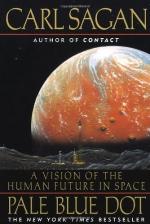
|
| Name: _________________________ | Period: ___________________ |
This test consists of 5 multiple choice questions, 5 short answer questions, and 10 short essay questions.
Multiple Choice Questions
1. The "great demotions" are changes in thinking about the status of what?
(a) The dominance of religion.
(b) The age of the Earth.
(c) The place of humanity in the universe.
(d) The body of human scientific work.
2. What is unusual about Uranus's orientation?
(a) It wobbles constantly.
(b) It is laid on its side.
(c) It is the only planet that lies perfectly in the ecliptic.
(d) It shifts from time to time.
3. How likely does Sagan think it is that the records on Voyager will eventually be found?
(a) It is almost certain.
(b) It is almost impossible.
(c) It is reasonably likely.
(d) It is unlikely.
4. What is notable about the stars in Sagan's distant picture of the Earth?
(a) An immense number are visible.
(b) They appear very close.
(c) They have many different colors.
(d) Very few are visible.
5. In what way is Titan's cold atmosphere an advantage for the formation of life?
(a) It helps certain compounds form quickly.
(b) It provides shields the moon from solar rays.
(c) It causes molecules to stay on its surface.
(d) It protects its inner core from tidal forces.
Short Answer Questions
1. Besides the Voyager spacecraft, what does Sagan cite as a major triumph by NASA?
2. Which of the following is NOT one of the major unknowns that Sagan says he will address in this book?
3. Who helped Sagan calculate that Titan should be host to oceans?
4. How much bigger is Neptune than Earth?
5. Many of organic molecules arrived on Earth from what source?
Short Essay Questions
1. What seemingly important features of humanity does Sagan deny to be distinguishing?
2. How did ancient people know about the planets?
3. What does the Strong Anthropomorphic principle suggest?
4. What problems does NASA face in pursuing its missions?
5. Why did ancient people believe there could not be any other planets beyond the ones they knew about?
6. What does Sagan believe about the intelligence of the Voyager spacecraft.
7. What does Sagan think about the failure of the Voyager probes to find life in the solar system?
8. As of 1990, what had the Voyager spacecraft achieved?
9. What planets had been explored by human beings, at the time of the writing of this book?
10. What dangers did the Voyager I spacecraft face in taking a distant picture of Earth?
|
This section contains 668 words (approx. 3 pages at 300 words per page) |

|




